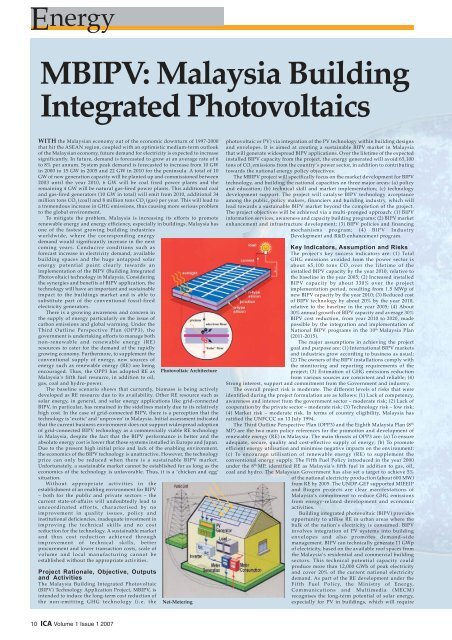ICA_Feb 07.pdf - Roof & Facade
ICA_Feb 07.pdf - Roof & Facade
ICA_Feb 07.pdf - Roof & Facade
You also want an ePaper? Increase the reach of your titles
YUMPU automatically turns print PDFs into web optimized ePapers that Google loves.
Energy<br />
MBIPV: Malaysia Building<br />
Integrated Photovoltaics<br />
WITH the Malaysian economy out of the economic downturn of 1997-2000<br />
that hit the ASEAN region, coupled with an optimistic medium-term outlook<br />
of the Malaysian economy, future demand for electricity is expected to increase<br />
significantly. In future, demand is forecasted to grow at an average rate of 6<br />
to 8% per annum. System peak demand is forecasted to increase from 10 GW<br />
in 2000 to 15 GW in 2005 and 22 GW in 2010 for the peninsula. A total of 10<br />
GW of new generation capacity will be planted up and commissioned between<br />
2003 until the year 2010, 6 GW will be coal fired power plants and the<br />
remaining 4 GW will be natural gas-fired power plants. This additional coal<br />
and gas-fired generators (10 GW in total) will emit from 2010, additional 34<br />
million tons CO 2<br />
(coal) and 8 million tons CO 2<br />
(gas) per year. This will lead to<br />
a tremendous increase in GHG emissions, thus causing more serious problem<br />
to the global environment.<br />
To mitigate the problem, Malaysia is increasing its efforts to promote<br />
renewable energy and energy efficiency, especially in buildings. Malaysia has<br />
one of the fastest growing building industries<br />
worldwide, where the corresponding energy<br />
demand would significantly increase in the next<br />
coming years. Conducive conditions such as<br />
forecast increase in electricity demand, available<br />
building spaces and the huge untapped solar<br />
energy potential point clearly towards an<br />
implementation of the BIPV (Building Integrated<br />
Photovoltaic) technology in Malaysia. Considering<br />
the synergies and benefits of BIPV application, the<br />
technology will have an important and sustainable<br />
impact to the buildings market and is able to<br />
substitute part of the conventional fossil-fired<br />
electricity generators.<br />
There is a growing awareness and concern in<br />
the supply of energy particularly on the issue of<br />
carbon emissions and global warming. Under the<br />
Third Outline Perspective Plan (OPP3), the<br />
government is undertaking efforts to manage both<br />
non-renewable and renewable energy (RE)<br />
resources to cater for the demand of the rapidly<br />
growing economy. Furthermore, to supplement the<br />
conventional supply of energy, new sources of<br />
energy such as renewable energy (RE) are being<br />
encouraged. Thus, the OPP3 has adopted RE as Photovoltaic Architecture<br />
Malaysia’s fifth fuel resource, in addition to oil,<br />
gas, coal and hydro-power.<br />
The baseline scenario shows that currently, biomass is being actively<br />
developed as RE resource due to its availability. Other RE resource such as<br />
solar energy, in general, and solar energy applications like grid-connected<br />
BIPV, in particular, has remained in the sidelines mainly due to its relatively<br />
high cost. In the case of grid-connected BIPV, there is a perception that the<br />
technology is ‘exotic’ and ‘unproven’ in Malaysia. Initial assessment indicated<br />
that the current business environment does not support widespread adoption<br />
of grid-connected BIPV technology as a commercially viable RE technology<br />
in Malaysia, despite the fact that the BIPV performance is better and the<br />
absolute energy cost is lower that those systems installed in Europe and Japan.<br />
Due to the present high initial price and lack of the enabling environment,<br />
the economics of the BIPV technology is unattractive. However, the technology<br />
price can only be reduced when there is a sustainable BIPV market.<br />
Unfortunately, a sustainable market cannot be established for as long as the<br />
economics of the technology is unfavorable. Thus, it is a ‘chicken and egg’<br />
situation.<br />
Without appropriate activities in the<br />
establishment of an enabling environment for BIPV<br />
– both for the public and private sectors – the<br />
current state-of-affairs will undoubtedly lead to<br />
uncoordinated efforts, characterised by no<br />
improvement in quality issues, policy and<br />
institutional deficiencies, inadequate investment in<br />
improving the technical skills and no cost<br />
reduction for the technology. A sustainable market<br />
and thus cost reduction achieved through<br />
improvement of technical skills, better<br />
procurement and lower transaction costs, scale of<br />
volume and local manufacturing cannot be<br />
established without the appropriate activities.<br />
Project Rationale, Objective, Outputs<br />
and Activities<br />
The Malaysia Building Integrated Photovoltaic<br />
(BIPV) Technology Application Project, MBIPV, is<br />
intended to induce the long-term cost reduction of<br />
the non-emitting GHG technology (i.e. the<br />
Net-Metering<br />
photovoltaic or PV) via integration of the PV technology within building designs<br />
and envelopes. It is aimed at creating a sustainable BIPV market in Malaysia<br />
that will generate widespread BIPV applications. Over the lifetime of the expected<br />
installed BIPV capacity from the project, the energy generated will avoid 65,100<br />
tons of CO 2<br />
emissions from the country’s power sector, in addition to contributing<br />
towards the national energy policy objectives.<br />
The MBIPV project will specifically focus on the market development for BIPV<br />
technology, and building the national capacities on three major areas: (a) policy<br />
and education; (b) technical skill and market implementation; (c) technology<br />
development support. The project will catalyse BIPV technology acceptance<br />
among the public, policy makers, financiers and building industry, which will<br />
lead towards a sustainable BIPV market beyond the completion of the project.<br />
The project objectives will be achieved via a multi-pronged approach: (1) BIPV<br />
information services, awareness and capacity building programs; (2) BIPV market<br />
enhancement and infrastructure development; (3) BIPV policies and financing<br />
mechanisms program; (4) BIPV Industry<br />
Development and R&D enhancement program.<br />
Key Indicators, Assumption and Risks<br />
The project’s key success indicators are: (1) Total<br />
GHG emissions avoided from the power sector is<br />
about 65,100 tons CO 2<br />
over the lifetime of the<br />
installed BIPV capacity by the year 2010, relative to<br />
the baseline in the year 2005; (2) Increased installed<br />
BIPV capacity by about 330% over the project<br />
implementation period, resulting from 1.5 MWp of<br />
new BIPV capacity by the year 2010; (3) Reduced cost<br />
of BIPV technology by about 20% by the year 2010,<br />
relative to the baseline in the year 2005; (4) About<br />
30% annual growth of BIPV capacity and average 30%<br />
BIPV cost reduction, from year 2010 to 2020, made<br />
possible by the integration and implementation of<br />
National BIPV programs in the 10 th Malaysia Plan<br />
(2011-2015).<br />
The major assumptions in achieving the project<br />
goal and purpose are: (1) International BIPV markets<br />
and industries grow according to business as usual;<br />
(2) The owners of the BIPV installations comply with<br />
the monitoring and reporting requirements of the<br />
project; (3) Estimation of GHG emissions reduction<br />
from various sources are consistent and reliable; (4)<br />
Strong interest, support and commitment from the Government and industry.<br />
The overall project risk is moderate. The different levels of risks that were<br />
identified during the project formulation are as follows: (1) Lack of competency,<br />
awareness and interest from the government sector – moderate risk; (2) Lack of<br />
cooperation by the private sector – moderate risk; (3) Technology risk – low risk;<br />
(4) Market risk – moderate risk. In terms of country eligibility, Malaysia has<br />
ratified the UNFCCC on 13 July 1994.<br />
The Third Outline Perspective Plan (OPP3) and the Eighth Malaysia Plan (8 th<br />
MP) are the two main policy references for the promotion and development of<br />
renewable energy (RE) in Malaysia. The main thrusts of OPP3 are: (a) To ensure<br />
adequate, secure, quality and cost-effective supply of energy; (b) To promote<br />
efficient energy utilisation and minimise negative impacts on the environment;<br />
(c) To encourage utilisation of renewable energy (RE) to supplement the<br />
conventional energy supply. The Fifth Fuel Policy introduced in the year 2000<br />
under the 8 th MP, identified RE as Malaysia’s fifth fuel in addition to gas, oil,<br />
coal and hydro. The Malaysian Government has also set a target to achieve 5%<br />
of the national electricity production (about 600 MW)<br />
from RE by 2005. The UNDP-GEF supported MIEEIP<br />
and Biogen projects are clear manifestations of<br />
Malaysia’s commitment to reduce GHG emissions<br />
from energy-related development and economic<br />
activities.<br />
Building integrated photovoltaic (BIPV) provides<br />
opportunity to utilise RE in urban areas where the<br />
bulk of the nation’s electricity is consumed. BIPV<br />
involves integration of PV systems into building<br />
envelopes and also promotes demand-side<br />
management. BIPV can technically generate 11 GWp<br />
of electricity, based on the available roof spaces from<br />
the Malaysia’s residential and commercial building<br />
sectors. This technical potential capacity could<br />
produce more than 12,000 GWh of peak electricity<br />
and cover 20% of the current national electricity<br />
demand. As part of the RE development under the<br />
Fifth Fuel Policy, the Ministry of Energy,<br />
Communications and Multimedia (MECM)<br />
recognises the long-term potential of solar energy,<br />
especially for PV in buildings, which will require<br />
10 <strong>ICA</strong> Volume 1 Issue 1 2007
















